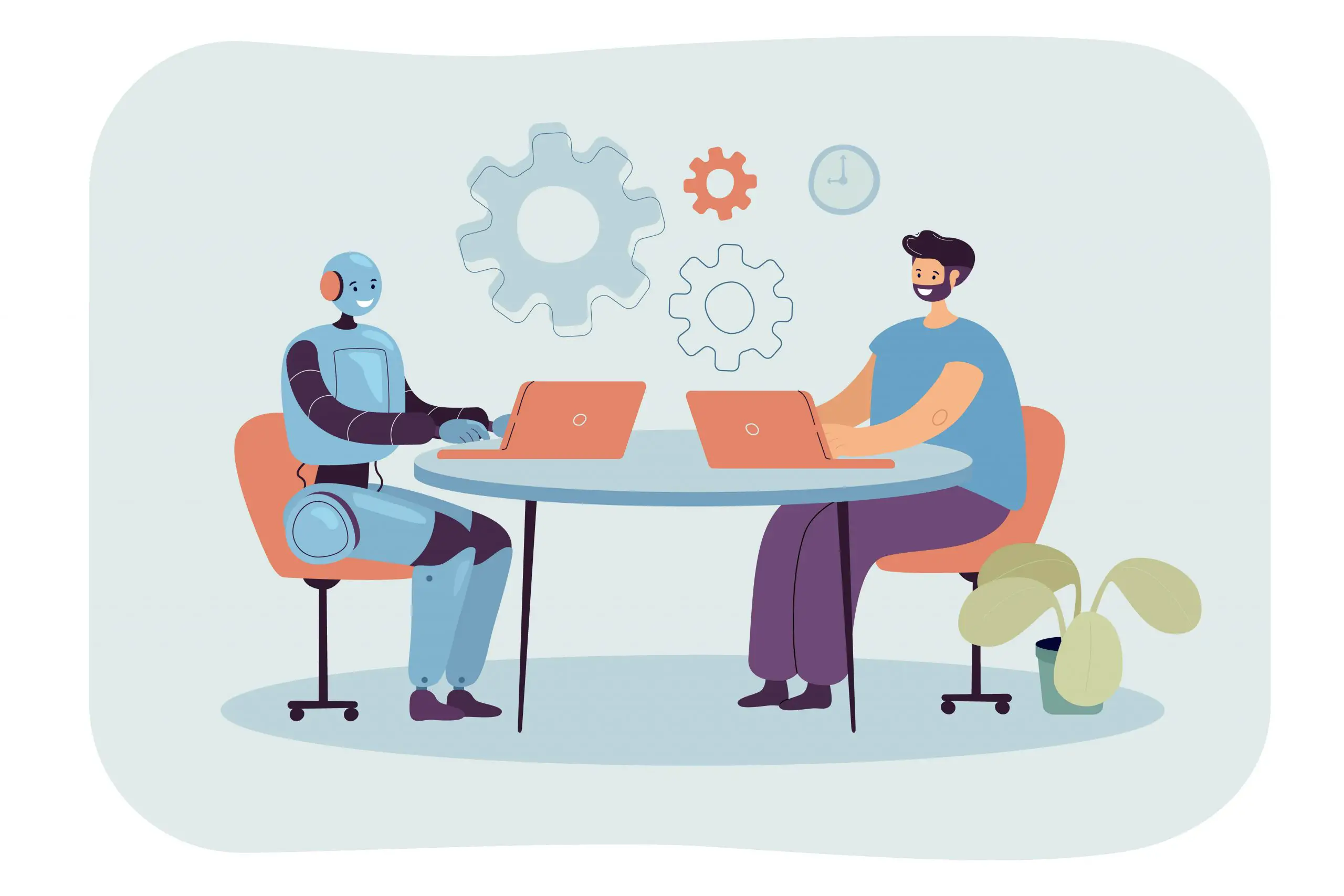Introduction
Artificial Intelligence (AI) and Machine Learning (ML) have become indispensable components of numerous businesses.
The surge in popularity of virtual assistants and chatbots comes as no surprise. While they share similarities, their design, and purpose are the main distinction. The design of virtual assistants can handle a wide range of requests, whereas chatbots tend to have more specific functionalities.
These technologies deliver personalized assistance, aid users with everyday tasks, and serve as a reliable second resource, freeing individuals from mundane and repetitive work.
This blog post delves into a comprehensive comparison between chatbots and virtual assistants. We will highlight their fundamental differences, operational mechanisms, benefits, and more.
What Is a Chatbot?
Chatbot development services create software programs designed to engage in human-like conversations with customers, or the chatbot! Businesses deploy chatbots to interact with customers and provide assistance 24/7. To illustrate the role of a chatbot, let us consider the example of Barney.
Barney is an e-commerce chatbot deployed by Barney and Flowers, a unique gift shop that offers a lovely combination of dinosaurs and flowers as gifts. As a digital customer service and sales representative, Barney performs the following tasks:
- Assists customers with tracking updates on their deliveries
- Guides customers through the customization and order placement process
- Automates workflows for refund and reschedule requests, delivering prompt resolutions.
- Addresses inquiries about available customizations, showcasing relevant images.
Barney operates as a customer chatbot, fulfilling the functions designed by the team at Barney and Flowers. If Barney encounters a request beyond its capabilities, it transfers the conversation to a human agent.
Chatbots possess contextual awareness, enabling them to understand the conversation’s context and execute appropriate bot flows. However, chatbots cannot independently find answers or perform activities beyond their predefined capabilities.
In contrast, a virtual assistant can leverage existing resources to assist with various requests.
Also Read: The Future of Chatbot Development: Trends to Watch
What Is a Virtual Assistant?
Intelligent virtual assistants, also known as virtual assistants or intelligent personal assistants, are online tools that assist individuals with various day-to-day activities. Some of these activities include email management, meeting scheduling, and more. Well-known virtual assistants include Google Assistant, Amazon Alexa, Apple’s Siri, and Microsoft’s Cortana.
While these virtual assistants excel at assisting with everyday tasks, they have limitations when it comes to customer service. They need help to resolve customer queries independently.
Now that we have a basic understanding of chatbots, and virtual assistants let us explore their critical differences in more detail.
Also Read: Siri vs. Alexa vs. Cortana: Comparing Virtual Personal Assistants
Chatbot vs. Virtual Assistant: What is the Difference?
To fully understand the distinctions between chatbots and virtual assistants, it is crucial to consider various aspects. Let us delve into these aspects in detail.
Interface
Support bots utilize a chat-like interface, the conversational user interface (CUI), enabling customers to engage with them through messages. Virtual assistants also offer a chat-like interface but can additionally operate without a visual interface, responding to voice commands for activation.
Technology
The comparison between chatbots and virtual assistants involves different technologies worth considering. While some chatbots rely on artificial intelligence (AI), others are rule-based and limited to pre-defined queries.
Virtual assistants share similar technological foundations with contextual chatbots. However, virtual assistants possess advanced natural language understanding (NLU) and artificial emotional intelligence capabilities. These enhancements enable virtual assistants to comprehend natural language commands better.
Furthermore, virtual assistants leverage search engines like Google and Bing and various applications to gather information and convert it into text or voice-based responses.
With the aid of advanced technology, virtual assistants can grasp the semantics, context, sentiment, and other subtleties inherent in human communication. Consequently, they exhibit a higher level of clarity in understanding natural language queries and provide outcomes that are more accurate.
Moreover, virtual assistants continuously learn from each interaction, allowing them to collect user-specific information and deliver more personalized responses in subsequent interactions.
Platforms
Businesses utilize chatbots across various platforms, including websites, support portals, messaging channels like WhatsApp and Facebook Messenger, mobile applications, and in-app chat widgets. They serve customer issues through these channels.
On the other hand, you can integrate virtual assistants into specific devices. Devices like Google Home and Amazon Echo have their respective built-in virtual assistants. These devices primarily operate through voice commands.
In contrast, mobile phones and laptops typically have applications that allow users to interact with the virtual assistant in addition to voice commands.
While chatbots have been a prominent topic of discussion in recent years, another form of automation is gaining popularity: the virtual customer assistant. Voice assistants such as Siri and Alexa exemplify this type of virtual customer assistant, providing immediate access to information and services with just a few spoken words.
Functionality
Functionality plays a crucial role when comparing intelligent virtual assistants to chatbots; you can determine the role by the specific needs each program addresses.
Chatbots primarily focus on addressing a particular need for many individuals, commonly involving basic communication between businesses and customers. As a result, their capabilities need to be improved in handling simple conversations.
In contrast, the technology behind virtual assistants tends to offer more extensive assistance. They aim to assist users with a variety of recurring tasks such as note-taking, making calls, scheduling appointments, reading messages aloud, and more.
A key differentiating factor is that virtual assistants can perform actions and conduct research independently. Therefore, while chatbots concentrate on a specific function, virtual assistants extend their functionality to provide comprehensive support and carry out tasks independently.
Also Read: How Can We Make Chatbots Intelligent?
Virtual Assistants or Chatbot: Which One is Better?
There are no winners or losers when comparing chatbots and virtual assistants. The choice depends on which one aligns better with your specific requirements.
The first decision is whether you need a personal virtual or customer service/business assistant. A personal virtual assistant is ideal if you aim to enhance productivity, organize daily tasks, and accomplish small tasks efficiently.
Virtual assistants excel at engaging in human-like, personalized conversations, gathering insights into customer behavior, organizing internal business activities, and preserving and sharing institutional knowledge.
Expert chatbot development services reveal that a chatbot is a suitable tool for simple customer queries, providing round-the-clock resolution. However, a virtual assistant is more beneficial if your business requires a more robust solution to streamline operations and enhance customer communication.
You can program both chatbots and virtual assistants to handle common customer queries. Chatbots, as semi-automated systems, can swiftly and efficiently handle simple issues. However, virtual assistants surpass chatbots for complex or time-sensitive matters like fraud detection in delivering prompt and effective responses.
How to Create a Chatbot
Chatbot creation has become more intuitive and, as a result, more accessible to a broader variety of brands and enterprises. That’s mainly because of the advent of no-code platforms.
But do you want to know how to create a chatbot that caters to all aspects of your business?
You may need professional chatbot development services for creating chatbots that automate client communication. Look for professional chatbot development services that provide unique chatbot solutions for your apps and websites.
Using powerful technologies and tools, chatbot development services can provide customized chatbot development solutions to meet your business needs.
Also Read: How to Make an AI Chatbot – No Code Required.
References
“How to Create a Chatbot – Intelvue.com”
“https://www.intelvue.com/a-step-by-step-guide-how-to-create-a-chatbot/” Accessed 18 July, 2023.
“It’s time to get a Virtual Assistant. Here’s Why – Entrepreneur.com”
“https://www.entrepreneur.com/science-technology/its-time-to-get-a-virtual-assistant-heres-why/359706” Accessed 18 July, 2023
“Yes, Chatbots And Virtual Assistants Are Different! – Forbes.com”
“https://www.forbes.com/sites/cognitiveworld/2018/12/23/yes-chatbots-and-virtual-assistants-are-different/?sh=57f2d9806d7d” Accessed 18 July, 2023
“Chatbot” Wikipedia”
“https://en.wikipedia.org/wiki/Chatbot” Accessed 18 July, 2023


